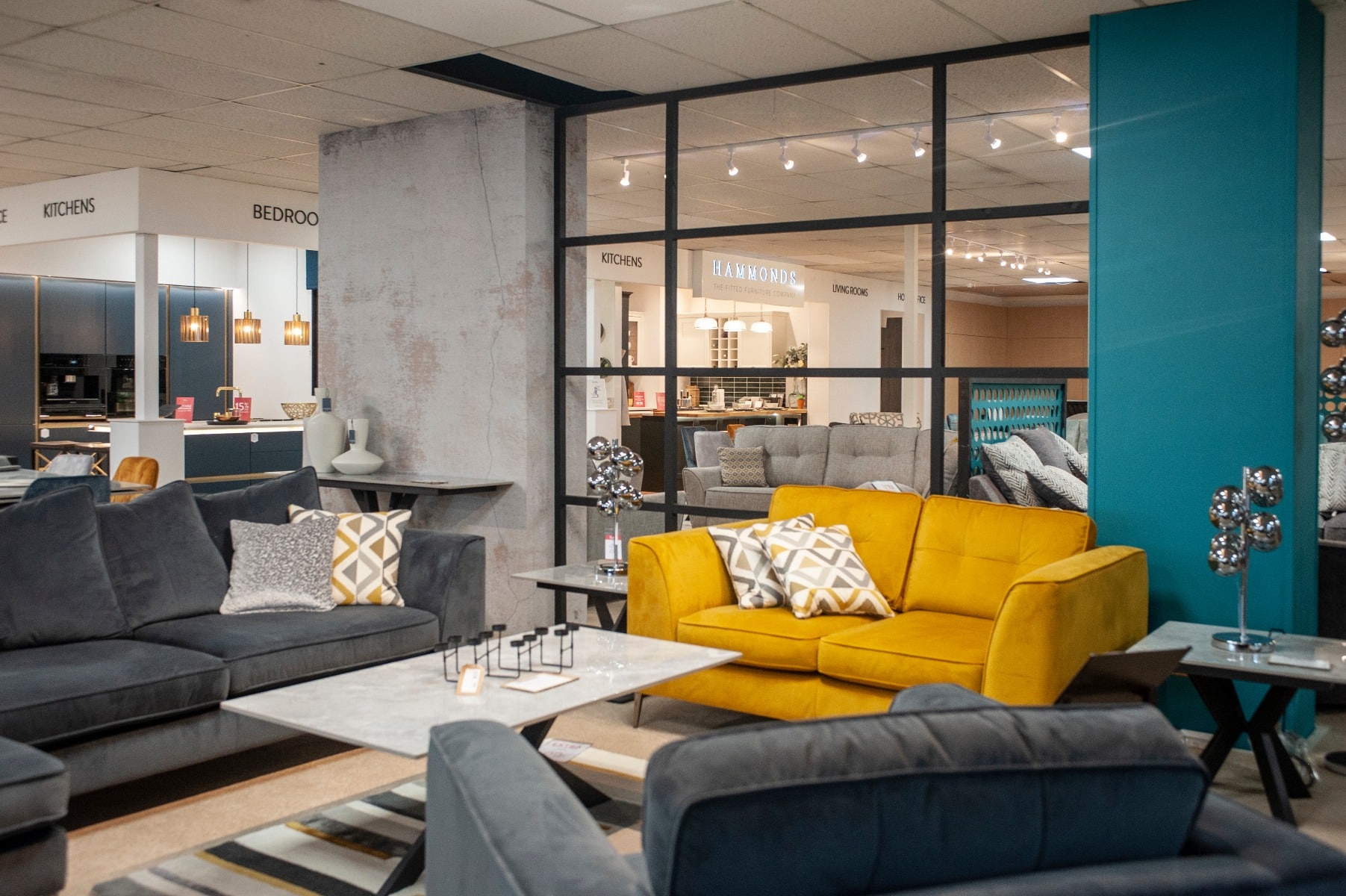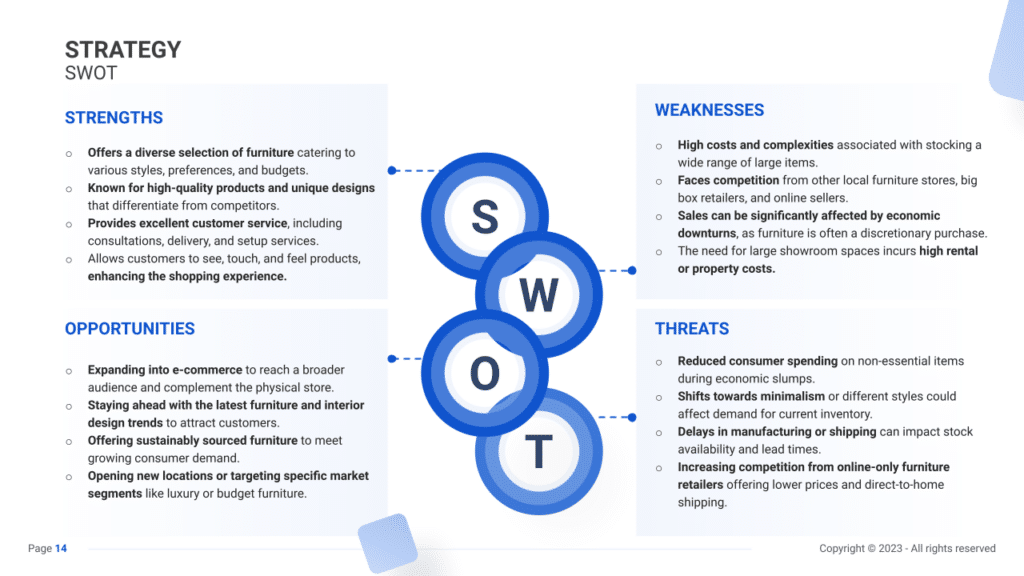SWOT Analysis for a Furniture Store (Example)

A SWOT analysis is crucial for developing a business plan for a furniture store. This analysis, which stands for Strengths, Weaknesses, Opportunities, and Threats, helps in understanding internal and external factors that can impact your business. Strengths and weaknesses are internal to the business, while opportunities and threats are external.
In this article, we will explore various examples of strengths, weaknesses, opportunities, and threats, aiding furniture store owners in incorporating these insights into their business strategies.

Strengths
Highlight strengths that distinguish the furniture store, fostering customer satisfaction and loyalty.
- Diverse Product Range and Quality Craftsmanship: Offering a wide array of furniture styles, coupled with superior craftsmanship and quality materials, sets the store apart.
- Example: Showcase craftsmanship and material quality through detailed product descriptions and in-store displays to emphasize uniqueness.
- Expert Customer Service and Design Consultations: Providing personalized design consultations and exceptional customer service elevates the shopping experience.
- Example: Focus on attentive service, expert design advice, and virtual or in-store consultations to enhance customer satisfaction.
- Established Supplier Relationships: Forging strong partnerships with reputable manufacturers or suppliers ensures access to exclusive collections and competitive pricing.
- Example: Highlight exclusive collections or limited-edition pieces sourced from trusted suppliers to attract discerning customers.
- Multichannel Sales and E-commerce Presence: Operating through multiple sales channels, including an intuitive e-commerce platform, extends market reach and accessibility.
- Example: Enhance the online store experience with 360-degree product views, virtual room setups, and seamless online transactions to attract online shoppers.
Weaknesses
Address weaknesses to fortify the furniture store’s market position and operational efficiency.
- Inventory Management and Storage Constraints: Managing diverse inventory and storage challenges may lead to stock shortages or excesses.
- Example: Implement efficient inventory tracking systems and optimize storage spaces to mitigate inventory-related issues.
- Seasonal Demand and Fashion Trends: Fluctuations in demand due to seasonal trends might lead to surplus stock or shortages.
- Example: Conduct trend analysis, collaborate with interior designers, and offer versatile designs to minimize the impact of seasonal variations.
- Pricing and Margins Pressure: Competing on price points with online retailers or larger furniture chains may affect margins.
- Example: Emphasize unique value propositions, craftsmanship, and tailored service to justify higher price points.
- Logistical Challenges and Delivery Times: Ensuring timely and efficient deliveries might pose logistical challenges, impacting customer satisfaction.
- Example: Invest in a reliable logistics network and communication channels to provide accurate delivery information and manage customer expectations.
Opportunities
Identify opportunities to augment and expand the furniture store’s market reach and relevance.
- Customization and Bespoke Furniture Services: Customization options or bespoke furniture services cater to individual preferences and niche markets.
- Example: Promote custom design options and collaborate with local artisans or interior designers to attract customers seeking unique pieces.
- Green and Sustainable Furniture Trends: Responding to the growing demand for eco-friendly furniture by offering sustainable and responsibly sourced products.
- Example: Highlight eco-friendly materials, certifications, or upcycled furniture collections to appeal to environmentally conscious consumers.
- Home Staging Services and Partnerships: Partnering with real estate agents or offering home staging services taps into the real estate market.
- Example: Collaborate with local realtors, offer home staging consultations, and showcase furniture in staged home settings for increased visibility.
- Expansion into Home Decor or Accessories: Incorporating complementary home decor items or accessories diversifies revenue streams.
- Example: Introduce a curated selection of home decor or collaborate with local artists for exclusive decor pieces to enhance the store’s appeal.
Threats
Prepare for threats to ensure the furniture store’s resilience and adaptability.
- Economic Volatility and Consumer Spending Patterns: Economic downturns might impact consumer spending on non-essential items like furniture.
- Example: Offer flexible financing options, promotional deals, or loyalty rewards during economic uncertainties to maintain customer engagement.
- Online Retail Dominance and Price Competition: Intense competition from online giants might challenge brick-and-mortar stores on pricing and convenience.
- Example: Focus on experiential shopping, unique product curation, and expert advice to counter online price competition.
- Supply Chain Disruptions and Material Shortages: Disruptions in the supply chain or material shortages might affect product availability and lead times.
- Example: Diversify suppliers, maintain buffer inventory, and communicate transparently with customers to manage expectations during shortages.
- Regulatory Changes and Tariffs: Alterations in trade regulations or the imposition of tariffs on imported furniture might impact pricing or availability.
- Example: Monitor trade policies, explore local sourcing options, and assess pricing strategies to address potential tariff impacts.





